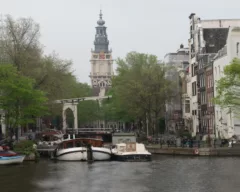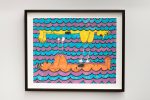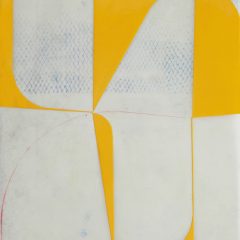—Rachel visits Berlin and introduces us to art world gems both old and new. –the Artblog editors———————–>
Berlin has the reputation for being the best space for contemporary art in the world – and I cannot disagree. A city cut in half and joined together by simply erasing the scar, Berlin’s history is felt through each step along its streets. Its contemporary history has carved out pockets for expression and debate so that the political is always right there – making the city’s art ever more impactful and relevant. Five days in June provided a tiny, though profound, introduction to a city at the forefront of contemporary artistic dialogue.
The Wall, museums and history
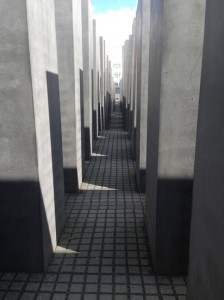
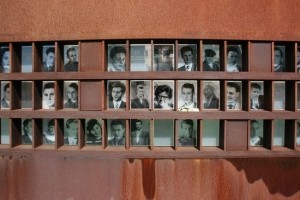
Before diving into Berlin’s contemporary scene, one must revisit the historical. Day one included the Reichstag, the Holocaust Memorial, Checkpoint Charlie, and, of course, the Wall. The Berlin Wall Memorial on Bernauer Strasse provides a telling narrative of the stark historical division. Testimonies and identity photographs of victims in the “Window of Remembrance” give face to invisible actions.
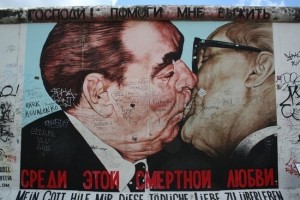
To view the Wall’s iconic street art, head to the East Side Gallery between the Ostbahnhof and Oberbaum Bridge. For nearly 1300 meters, you’ll stroll along artists’ interpretations of freedom, artistic expression, memory, and celebration. Originally painted in 1990 by 118 artists from more than 20 countries, the wall sections were revisited in 2009 as artists added fresh coats of paint to the graffiti-filled originals, and, occasionally, contemporary interpretations. A handful of the murals, like those by Thierry Noir, Dmitri Vrubel, and César Olhagaray, balance the graphic with their message in the way every street artist strives for, while all fit the open-air gallery’s need to mark, express, and publicly remember.

Berlin has a vast number of museums and traditional galleries to choose from. Rather than Museum Island (home to the National Gallery and Pergamon Museum, famous for the bust of Nefertiti), I opted for the Gemäldegalerie in the Kulturforum. The Gemälde’s remarkable collection of old German painting of the Late Gothic and Renaissance includes a Bruegel that will hold you for twenty minutes. Sixteen Rembrandts have you moving back and forth between contrasts and expressions; and Vermeers, Van Eycks and Reubenses remind you why the masters are the masters. A tip: If you decline the claustrophobia of audio guides, bring a German dictionary. The text plates are in German only.
Modern and contemporary in the Berlinsche Galerie of Modern Art
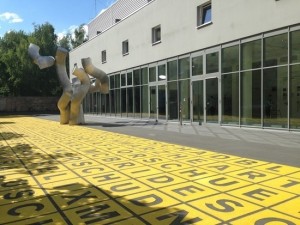
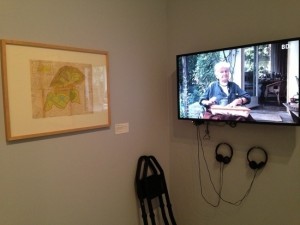
For a survey of the art of Berlin, the Berlinsche Gallerie Museum of Modern Art on Jakobstrasse is the best. The Museum’s permanent exhibition, Art in Berlin 1880-1980, chronicles the city’s artistic practices in a wonderfully educational and challenging manner– without falling into the trap of the dry or overwhelming chronology show. The exhibition guides visitors through Expressionism, Dada, the European Avant-Garde, and Art in the National Socialist Era seamlessly, with side handouts on the Nazi Degenerate Art Show providing context to the visual. Works by Felix Nussbaum, Herbert Kaufmann, and Hannah Höch are permanent standouts, with temporary inclusions of KP Brehmer’s cartographic works and Hilde Westrom’s architectural renderings giving voice to the complicated and diverse nature of Berlin’s art history.
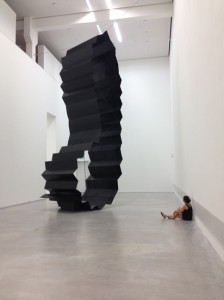
Also on view at the Berlinsche are exhibitions by contemporary Berlin artists Tobias Zielony and Katja Strunz. Zielony’s photographic projects “Jenny Jenny” (2011-2013) and “Trona” (2008) are outstanding glimpses into the lives of young people existing on the margins of institutional breakdown, while Strunz’s minimalist sculptures explore concepts such as material aging — on a monumental scale. Both artists exhibit wisdom in material sensibility that will surely develop even stronger over time.
Wandering the streets and a prize discovery
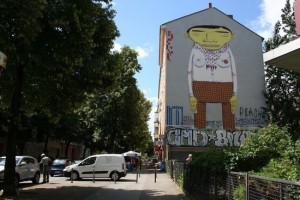
The gem of Berlin is simply wandering and discovering art in every neighborhood. I kept turning street corners and encountering murals by Os Gemeos, wheatpastes by JR, and graffiti by local artists. Amateur graffiti and tagging is pervasive, with the youth still believing in the power of an individual’s name, often to the detriment of great public art. For the best street art head to the Schlesisches Tor station.
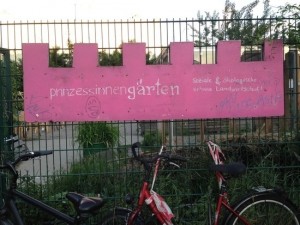
The best surprise discovery was Prinzessinnengarten, an artist/activist run community garden on the Moritzplatz. Lending libraries, organic cafes, and a garden bar complete the urban lot full of sustainable agricultural projects. In one corner of the garden, Canadian based artist Hye-Seung Jung creates a space for visitors to write their hopes for the places in which they live on individual wooden plaques, and then hang them within composed environments. The work, City of Wishes: Berlin, allows the garden to take on a global perspective as visitors imagine possibilities for urban spaces within an already thriving civic intervention. (Philly should really take a note from these activists).
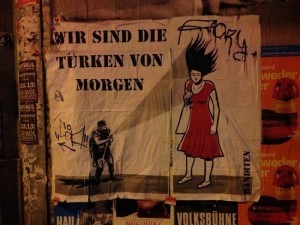
Also off the Moritzplatz and along Oranianstrasse you’ll encounter a young nightlife scene with Kebab stands, Mexican tequila joints, and traditional beer gardens. The large Turkish presence is clear in the street art, such as a wheatpaste of the now iconic Turkish student protester in a red dress being tear gassed.
The Mitte neighborhood – like the Lower East Side
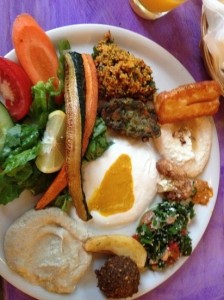
Berlin’s standout neighborhood is Mitte, full of independent boutiques, galleries, and conceptual spaces, making it feel like the Lower East Side– with far cleaner sidewalks. It is also a fantastic spot for an eclectic offering of restaurants and nightlife, such as Yarok, a Syrian hummus and falafel joint, Rothaus, for delectable dark German bread and homemade jam, and Zosch, a bar with a great outdoor ambiance and live music on the weekends. For art, Augustrasse is the gallery row and home to the best space for discussion of contemporary culture in Berlin, the KW Institute for Contemporary Art.
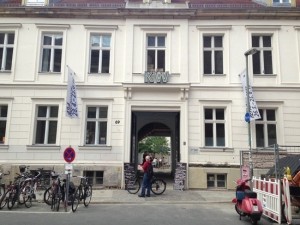
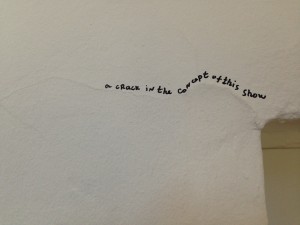
Without a permanent collection, the KW maintains a cultural environment in constant negotiation with the sociopolitical. Curator notes, leftover from a collaborative project between artist Nedko Solakov and Chief Curator Ellen Blumenstein, are sprinkled throughout the former margarine factory. A crack in the wall has the message “A crack in the concept of this show.” Two stick figures appear at various heights: “a curator in a strong position” and “a curator in a not so strong position.” The wit ascribes narrative to the KW’s building, a small reminder of the hands and thoughts of those the viewer rarely encounters.
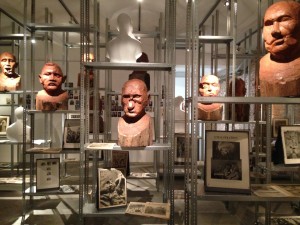
On view through August 25th is French-Algerian artist Kader Attia’s Repair: 5 Acts. Attia explores the cultural exchange between Europe and Africa, with an intensified focus on colonialism, through varied historical viewpoints, materials, and mediums. African pop music, traditional masks lined with mirrors, slide projections of documentary photographs, taxidermy cheetahs, and natural history illustrations bring a critical eye to a history that remains in constant negotiation. Broken up into five acts – culture, politics, science, nature, and repair in continuity – Attia’s piece holds you, the viewer, implicated in the narrative in a work that will keep you thinking for days. [Ed. note – Attia’s piece, in whole or part, was at Documenta 13 in Kassel. See Roberta’s post, which mentions it.]
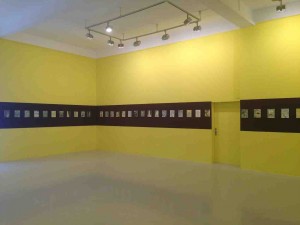
My final stop in Berlin was the n.b.k gallery on the Chausseestrasse, also in Mitte. Valérie Favre’s Selbstmord. Suicide, which closed July 28, 2013, is a powerful exhibition wrapped in the dramatization of life and death. The Suicide Cycle (2003-2013) presents 129 small format paintings representing the moment of life’s end. Each canvas depicts a different method, narrative, or cause, painted in a hazy, unfinished manner that reflects our inability to witness this private and intimate act. Familiar figures such as Mark Rothko, Sylvia Plath, and Vincent Van Gogh take their place in the scenes, while other narratives are drawn from the artist’s imagination, newspaper reports, or historical tales. The individual canvases exude an air of solitude that exists in contrast to the room’s collectivity, inviting us to reflect on both the intimate and the communal through sublime imaginations.
An enormous metropolis with an even larger history, Berlin deserves far more time to explore all its nooks and corners. But five days is enough to taste the degree of artistry, diligence, and concern with the cultural that expands that history and makes Berlin the leading space for the contemporary.


